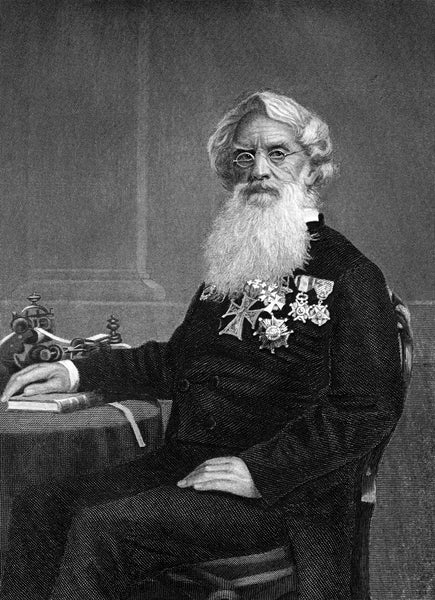Celebrating Morse Code Day: The Legacy of Samuel Morse
Apr 27, 2024
In the rich tapestry of history, there are threads that stand out not just for their age, but for their significance in connecting the stories of human achievement. This Morse Code Day, we pay homage to one of those threads, Samuel Morse, and the remarkable legacy he wove with a series of dots and dashes. To the uninitiated, it may seem a simple system of communication, but the tale behind Morse Code and its progenitor is fascinating as it is crucial to the tapestry of modern life, and it begins with a man who was not just an inventor, but also a painter and a man of faith.

The Story of Samuel Morse
Samuel Morse did not set out to change the world of communication. Born in Charlestown, Massachusetts in 1791, Morse showed an early penchant for art, eventually making his way to London to study at the Royal Academy. It was during a return voyage from Europe in 1832 that the seeds of his future invention were sown. News traveled slowly, and upon learning of his wife's death, Morse found himself beset with the idea of a faster communication system.
Back on American shores, he became obsessed with the concept, learning of the electromagnet and its potential to drive his vision of a telegraph, a "writing telegraph" that could inscribe messages in a distant location. His steadfast dedication led to the invention of the telegraph and with it, the infamous Morse Code. This simple, yet powerful, signal encoding system was co-created with his collaborator Alfred Vail.
Revolutionizing Telegraphy
The telegraph was a ground-breaking invention, but the path to its creation was fraught with financial peril and political maneuvers. Against this backdrop, Morse’s invention, which could send messages across great distances at unheard-of speeds, showcased the ingenuity and tenacity that would define his career. The result was not just a patented device, but a transformation in how we viewed and traversed geographical space and time.
Morse's telegraph was quickly adopted for railway communications, allowing for unprecedented coordination and safety. The dots and dashes of Morse Code, initially conceived as a means of efficiently coding messages, became the universal language of the telegraph, a system so robust that it persisted well past the advent of modern telecommunications.

The Birth of Morse Code
In collaboration with Alfred Vail, Morse developed a signaling device that could transmit messages by an operator pressing down a key to complete an electrical circuit, thus allowing current to flow and marking a distant device to print out a corresponding letter or number. To convey the messages efficiently, Morse and Vail created a succinct code with each letter of the alphabet and a few special characters represented by a unique sequence of short and long electrical pulses, which we now know as Morse Code.
The resonance of Morse Code in human history is striking. From the tapping of prisoners sending messages of hope to the outside world, to naval communications and aviation, Morse Code became integral to our global story. It even extends to outer space, with Morse Code messages still being beamed to Earth from satellites and used as a backup communication method for space missions.
Morse Code's Modern-Day Relevance
One might think in this age of instant digital communication, Morse Code would be consigned to history books and museums. Yet, it persists as a crucial tool. Amateur radio operators use Morse Code as a form of communication and encryption that provides simple, effective, and — in the right hands — private dialogue. After all, the efficiency and clarity of Morse Code remain unmatched in environments where traditional language isn’t enough.
On Morse Code Day, one is reminded that the echoes of Morse’s invention resound louder than his era. Morse Code has become a cultural touchstone, inspiring writers from Dickens to Verne and serving as the basis for international distress signaling, most famously, S-O-S. It’s a testament to a system so elegantly simple that it survived the relentless march of time and technology.

Celebrating Samuel Morse's Impact
Samuel Morse was an unlikely hero of the industrial age, combining the precision of an artist’s brush with the technical savvy of a budding industrialist. His legacy extends beyond the dots and dashes that bear his name to the very heart of human innovation. Our collective appreciation for him is best summed up in the fact that almost two centuries later, we still gather to commemorate his invention.
Through the celebration of Morse Code Day, we not only recognize the impact of a single man’s creative genius but also pay respect to the concepts of determination and perseverance. Though Morse Code is no longer part of mainstream communication systems, it remains a valued part of our cultural and technological history. Its continued relevance serves as a powerful reminder of our shared human story and the individuals who sew the threads of progress.
The story of Samuel Morse and Morse Code is one that deserves regular retelling. May this Morse Code Day be another opportunity to share the narrative of inspiration and innovation that it embodies. As we honor Morse and the code named after him, we renew our commitment to not just passively consume the conveniences of communication but to reflect upon and appreciate the endeavors that made them possible.


